Size Control of Ti4O7 Nanoparticles by Carbothermal Reduction Using a Multimode Microwave Furnace
Abstract
1. Introduction
2. Materials and Methods
3. Results and Discussion
4. Conclusions
Author Contributions
Acknowledgments
Conflicts of Interest
References
- Andersson, S.; Collén, B.; Kuylenstierna, U.; Magnéli, A. Phase Analysis Studies on the Titanium-Oxygen System. Acta Chem. Scand. 1957, 11, 1641–1652. [Google Scholar] [CrossRef]
- Bartholomew, R.F.; Frankl, D.R. Electrical properties of some titanium oxides. Phys. Rev. 1969, 187, 828–833. [Google Scholar] [CrossRef]
- Smith, J.R.; Walsh, F.C. Electrodes based on Magneli phase titanium oxides: The properties and applications of Ebonex materials. J. Appl. Electrochem. 1998, 28, 1021–1033. [Google Scholar] [CrossRef]
- Walsh, F.C.; Wills, R.G.A. The continuing development of Magnéli phase titanium sub-oxides and Ebonex® electrodes. Electrochim. Acta 2010, 55, 6342–6351. [Google Scholar] [CrossRef]
- Ioroi, T.; Senoh, H.; Yamazaki, S.I.; Siroma, Z.; Fujiwara, N.; Yasuda, K. Stability of Corrosion-Resistant Magnéli-Phase Ti4O7-Supported PEMFC Catalysts at High Potentials. J. Electrochem. Soc. 2008, 155, B321. [Google Scholar] [CrossRef]
- Graves, J.E.; Pletcher, D.; Clarke, R.L.; Walsh, F.C. The electrochemistry of Magnéli phase titanium oxide ceramic electrodes Part I. The deposition and properties of metal coatings. J. Appl. Electrochem. 1991, 21, 848–857. [Google Scholar] [CrossRef]
- Chen, G.; Bare, S.R.; Mallouk, T.E. Development of Supported Bifunctional Electrocatalysts for Unitized Regenerative Fuel Cells. J. Electrochem. Soc. 2002, 149, A1092. [Google Scholar] [CrossRef]
- Won, J.; Kwak, D.; Han, S.; Park, H.; Park, J.; Ma, K.; Kim, D.; Park, K. PtIr/Ti4O7 as a bifunctional electrocatalyst for improved oxygen reduction and oxygen evolution reactions. J. Catal. 2018, 358, 287–294. [Google Scholar] [CrossRef]
- Ota, K.; Matsuzawa, K.; Nagai, T.; Ishihara, A.; Mitsushima, S. Stability of Group 4 and 5 Metal Oxide Cathode with Titanium Oxide Support for PEFCs. Meet. Abstr. 2016, MA2016-01, 1713. [Google Scholar]
- Ioroi, T.; Senoh, H.; Siroma, Z.; Yamazaki, S.; Fujiwara, N.; Yasuda, K. Stability of Corrosion-Resistant Magnéli-Phase Ti4O7-Supported PEMFC Catalysts. ECS Trans. 2007, 11, 1041–1048. [Google Scholar]
- Ioroi, T.; Akita, T.; Yamazaki, S.; Siroma, Z.; Fujiwara, N.; Yasuda, K. Corrosion-Resistant PEMFC Cathode Catalysts Based on a Magnéli-Phase Titanium Oxide Support Synthesized by Pulsed UV Laser Irradiation. J. Electrochem. Soc. 2011, 158, C329. [Google Scholar] [CrossRef]
- Mei, S.; Jafta, C.J.; Lauermann, I.; Ran, Q.; Kärgell, M.; Ballauff, M.; Lu, Y. Porous Ti4O7 Particles with Interconnected-Pore Structure as a High-Efficiency Polysulfide Mediator for Lithium–Sulfur Batteries. Adv. Funct. Mater. 2017, 27, 1–10. [Google Scholar] [CrossRef]
- Wei, H.; Rodriguez, E.F.; Best, A.S.; Hollenkamp, A.F.; Chen, D.; Caruso, R.A. Chemical Bonding and Physical Trapping of Sulfur in Mesoporous Magnéli Ti4O7 Microspheres for High-Performance Li–S Battery. Adv. Energy Mater. 2017, 7, 1601616. [Google Scholar] [CrossRef]
- Zhang, Y.; Yao, S.; Zhuang, R.; Luan, K.; Qian, X.; Xiang, J.; Shen, X.; Li, T.; Xiao, K.; Qin, S. Shape-controlled synthesis of Ti4O7 nanostructures under solvothermal-assisted heat treatment and its application in lithium-sulfur batteries. J. Alloys Compd. 2017, 729, 1136–1144. [Google Scholar] [CrossRef]
- Santos, M.C.; Elabd, Y.A.; Jing, Y.; Chaplin, B.P.; Fang, L. Highly Porous Ti4O7 Reactive Electrochemical Water Filtration Membranes Fabricated via Electrospinning/Electrospraying. AIChE J. 2016, 62, 508–524. [Google Scholar] [CrossRef]
- Guo, L.; Jing, Y.; Chaplin, B.P. Development and Characterization of Ultrafiltration TiO2 Magnéli Phase Reactive Electrochemical Membranes. Environ. Sci. Technol. 2016, 50, 1428–1436. [Google Scholar] [CrossRef] [PubMed]
- Pang, Q.; Kundu, D.; Cuisinier, M.; Nazar, L.F. Surface-enhanced redox chemistry of polysulphides on a metallic and polar host for lithium-sulphur batteries. Nat. Commun. 2014, 5, 4759. [Google Scholar] [CrossRef] [PubMed]
- Xu, B.; Zhao, D.; Sohn, H.Y.; Mohassab, Y.; Yang, B.; Lan, Y.; Yang, J. Flash synthesis of Magnéli phase (TinO2n−1) nanoparticles by thermal plasma treatment of H2TiO3. Ceram. Int. 2018, 44, 3929–3936. [Google Scholar] [CrossRef]
- Portehault, D.; Maneeratana, V.; Candolfi, C.; Oeschler, N.; Veremchuk, I.; Grin, Y.; Sanchez, C.; Antonietti, M. Facile general route toward tunable magnéli nanostructures and their use as thermoelectric metal oxide/carbon nanocomposites. ACS Nano 2011, 5, 9052–9061. [Google Scholar] [CrossRef] [PubMed]
- Huang, S.S.; Lin, Y.H.; Chuang, W.; Shao, P.S.; Chuang, C.H.; Lee, J.F.; Lu, M.L.; Weng, Y.T.; Wu, N.L. Synthesis of High-Performance Titanium Sub-Oxides for Electrochemical Applications Using Combination of Sol-Gel and Vacuum-Carbothermic Processes. ACS Sustain. Chem. Eng. 2018, 6, 3162–3168. [Google Scholar] [CrossRef]
- Ioroi, T.; Kageyama, H.; Akita, T.; Yasuda, K. Formation of electro-conductive titanium oxide fine particles by pulsed UV laser irradiation. Phys. Chem. Chem. Phys. 2010, 12, 7529. [Google Scholar] [CrossRef] [PubMed]
- Arif, A.F.; Balgis, R.; Ogi, T.; Iskandar, F.; Kinoshita, A.; Nakamura, K.; Okuyama, K. Highly conductive nano-sized Magnéli phases titanium oxide (TiOx). Sci. Rep. 2017, 7, 3646. [Google Scholar] [CrossRef] [PubMed]
- Han, W.Q.; Zhang, Y. Magnéli phases TinO2n−1 nanowires: Formation, optical, and transport properties. Appl. Phys. Lett. 2008, 92, 203117. [Google Scholar] [CrossRef]
- Toyoda, M.; Yano, T.; Tryba, B.; Mozia, S.; Tsumura, T.; Inagaki, M. Preparation of carbon-coated Magneli phases TinO2n−1 and their photocatalytic activity under visible light. Appl. Catal. B Environ. 2009, 88, 160–164. [Google Scholar] [CrossRef]
- Takeuchi, T.; Fukushima, J.; Hayashi, Y.; Takizawa, H. Synthesis of Ti4O7 Nanoparticles by Carbothermal Reduction Using Microwave Rapid Heating. Catalysts 2017, 7, 65. [Google Scholar] [CrossRef]
- Fukushima, J.; Takeuchi, T.; Hayashi, Y.; Takizawa, H. Microwave synthesis of carbon-coated Ti4O7 nanorods by rapid carbothermal reduction processing. Chem. Eng. Process. Process Intensif. 2018, 125, 27–33. [Google Scholar] [CrossRef]
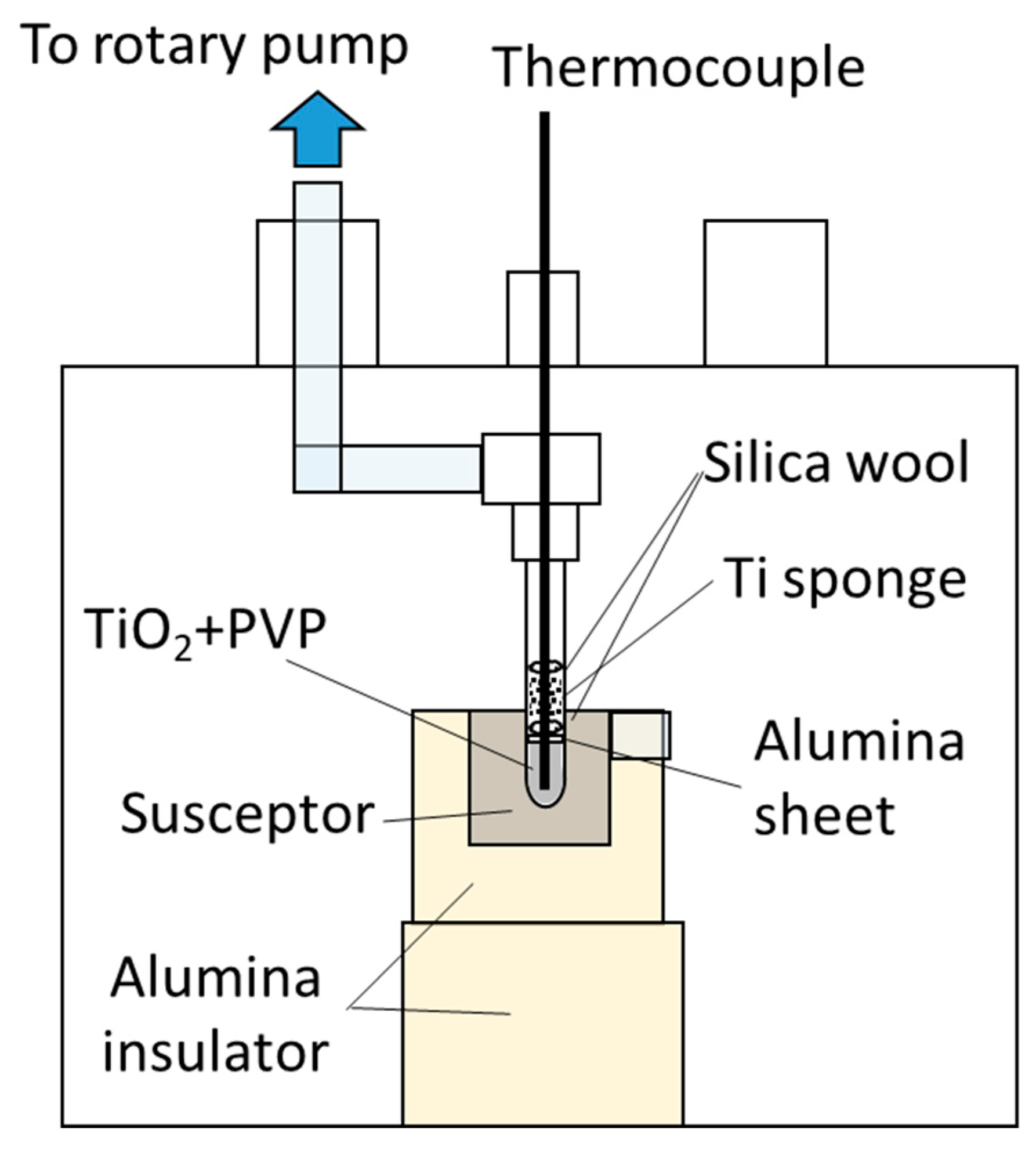
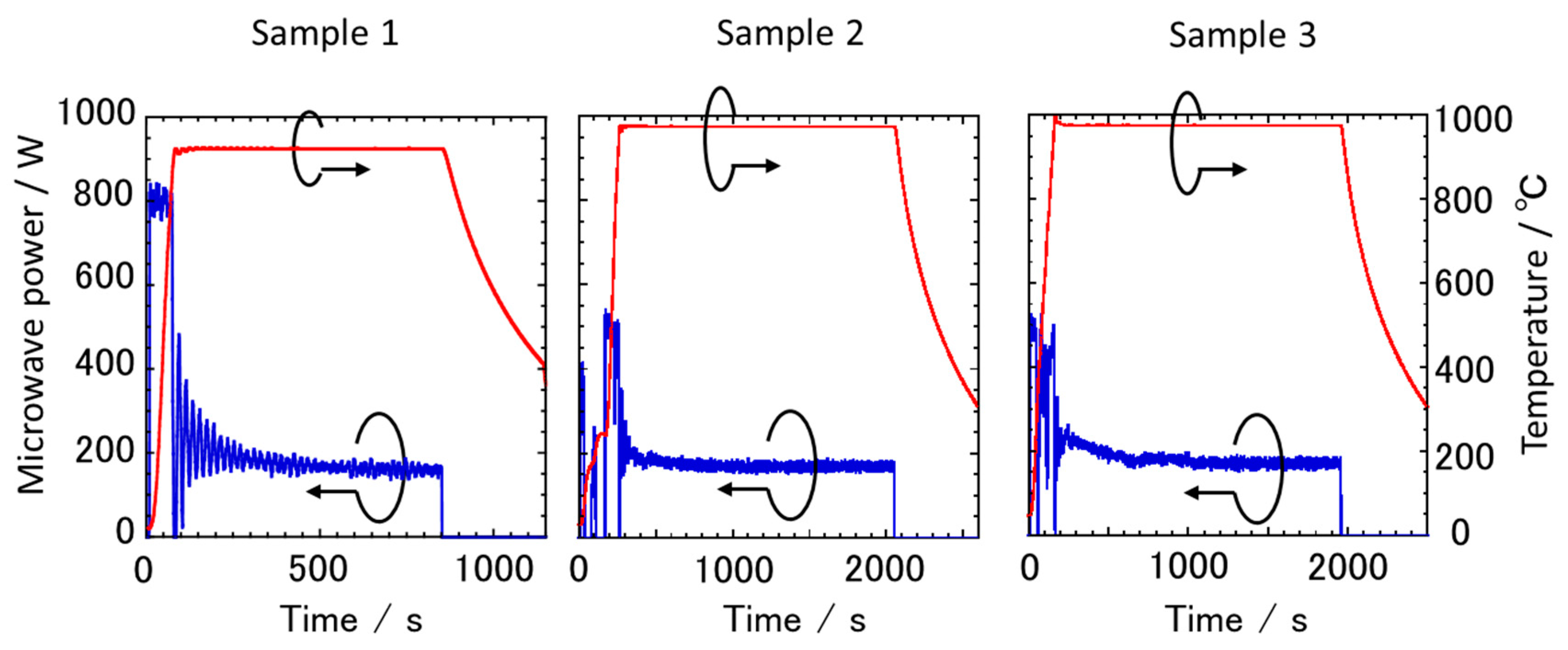
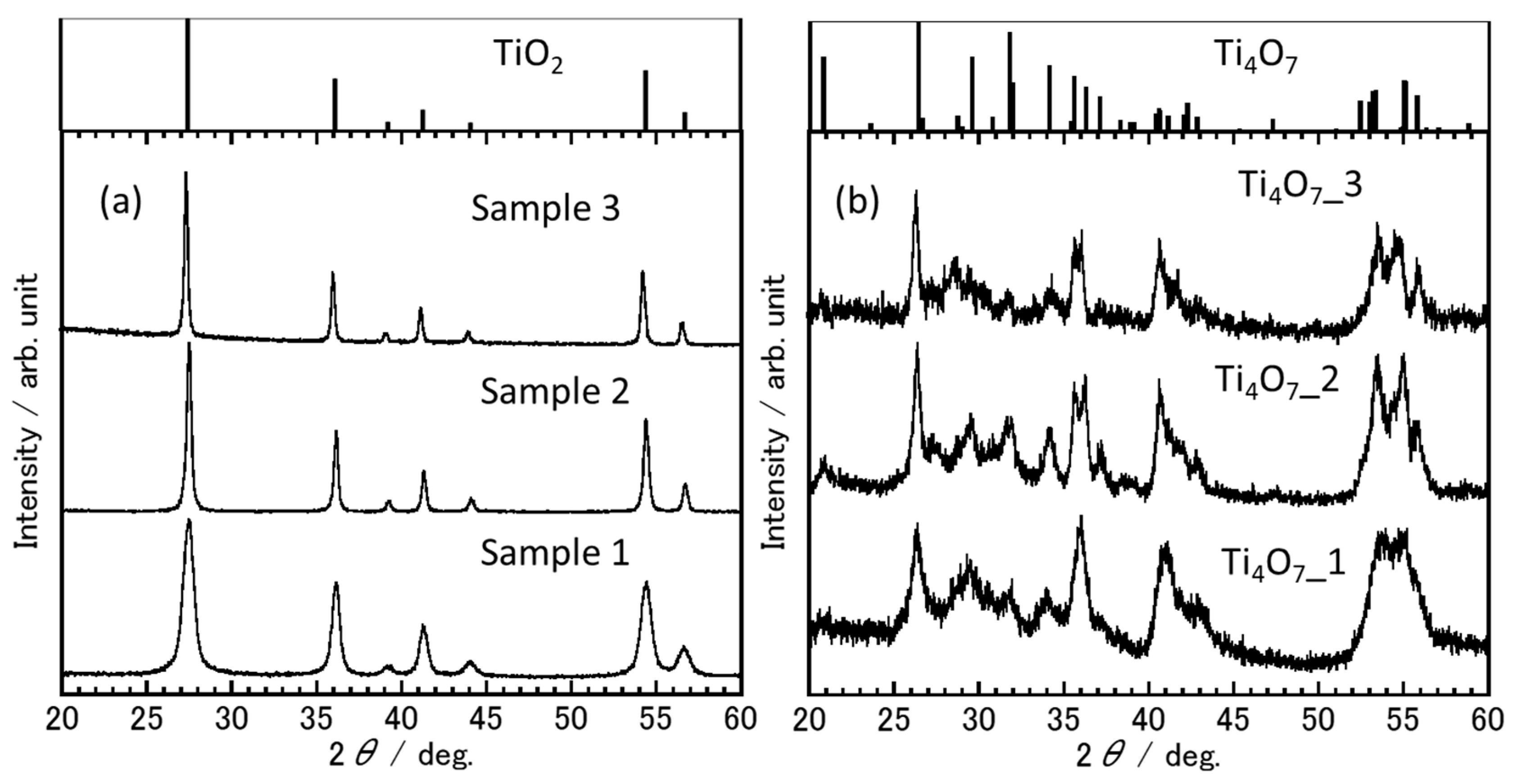

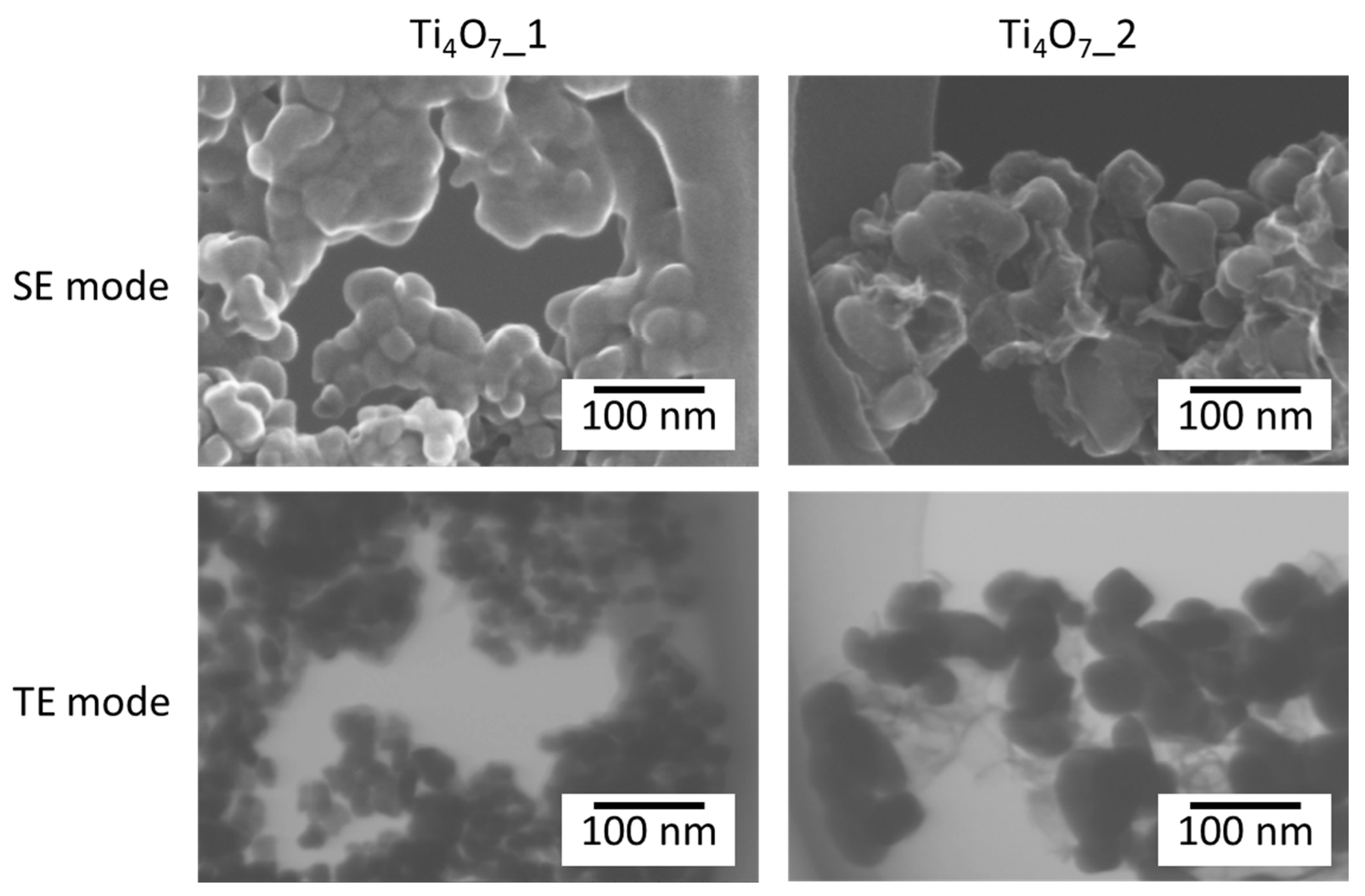
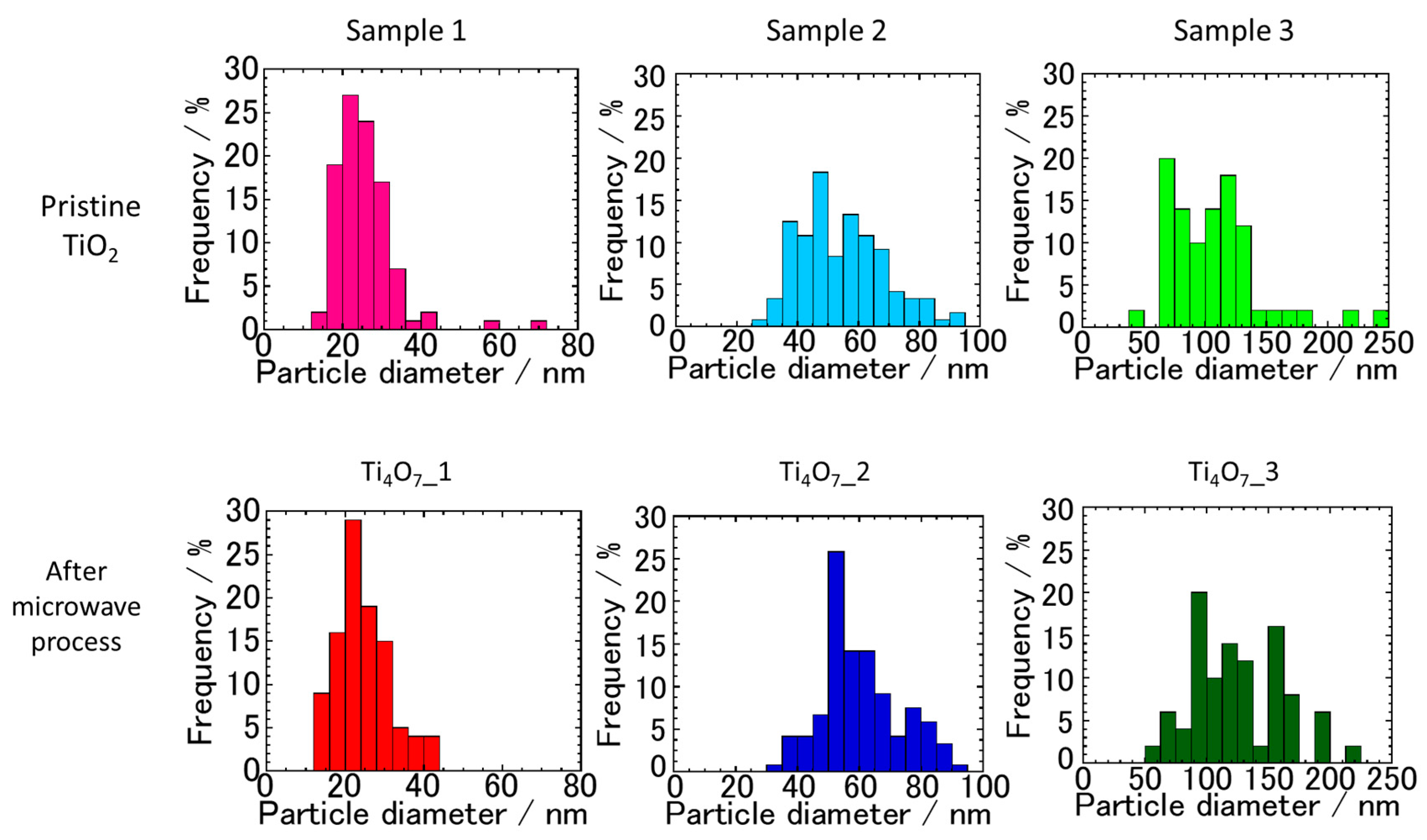
| No. | Rate of Heating/°C s−1 | Holding Temperature/°C | Holding Time/min. | Synthesized Phase |
|---|---|---|---|---|
| 1 | 12.0 | 900 | 10 | TiO2 |
| 2 | 12.0 | 925 | 10 | Ti7O13 + Ti4O7 |
| 3 | 12.0 | 925 | 11 | Ti4O7 + Ti6O11 |
| 4 | 12.0 | 925 | 13 | Ti4O7 |
| 5 | 12.0 | 925 | 15 | Ti4O7 + Ti3O5 |
| 6 | 12.0 | 925 | 20 | Ti3O5 + Ti4O7 |
| 7 | 10.0 | 950 | 30 | Ti3O5 + Ti2O3 |
| No. | Rate of Heating /°C s−1 | Holding Temperature/°C | Holding Time/min. | Microwave Power @ Holding/W |
|---|---|---|---|---|
| Sample 1 | 12.0 | 925 | 13 | 168.0 |
| Sample 2 | 3.4 | 975 | 30 | 171.0 |
| Sample 3 | 5.7 | 975 | 30 | 181.1 |
| Before MW Process | After MW Process | |
|---|---|---|
| Sample 1 | 9.2 (0.3) nm | 9.2 nm |
| Sample 2 | 28.3 (0.4) nm | 25.3 nm |
| Sample 3 | 31.0 (0.9) nm | 29.5 nm |
| No. | Ave. Diameter/nm | S.D./nm | Max./nm | Min./nm | n/- | S.E./nm |
|---|---|---|---|---|---|---|
| Sample 1 | 25.8 | 7.9 | 69.5 | 13.9 | 100 | 0.8 |
| Ti4O7_1 | 24.7 | 6.7 | 43.5 | 12.2 | 100 | 0.7 |
| Sample 2 | 54.6 | 13.9 | 91.1 | 29.2 | 120 | 1.3 |
| Ti4O7_2 | 60.4 | 12.8 | 94.6 | 30.7 | 120 | 1.2 |
| Sample 3 | 108.0 | 38.0 | 246.2 | 41.8 | 50 | 5.4 |
| Ti4O7_3 | 125.0 | 37.5 | 215.6 | 51.0 | 50 | 5.3 |
© 2018 by the authors. Licensee MDPI, Basel, Switzerland. This article is an open access article distributed under the terms and conditions of the Creative Commons Attribution (CC BY) license (http://creativecommons.org/licenses/by/4.0/).
Share and Cite
Fukushima, J.; Takizawa, H. Size Control of Ti4O7 Nanoparticles by Carbothermal Reduction Using a Multimode Microwave Furnace. Crystals 2018, 8, 444. https://doi.org/10.3390/cryst8120444
Fukushima J, Takizawa H. Size Control of Ti4O7 Nanoparticles by Carbothermal Reduction Using a Multimode Microwave Furnace. Crystals. 2018; 8(12):444. https://doi.org/10.3390/cryst8120444
Chicago/Turabian StyleFukushima, Jun, and Hirotsugu Takizawa. 2018. "Size Control of Ti4O7 Nanoparticles by Carbothermal Reduction Using a Multimode Microwave Furnace" Crystals 8, no. 12: 444. https://doi.org/10.3390/cryst8120444
APA StyleFukushima, J., & Takizawa, H. (2018). Size Control of Ti4O7 Nanoparticles by Carbothermal Reduction Using a Multimode Microwave Furnace. Crystals, 8(12), 444. https://doi.org/10.3390/cryst8120444






